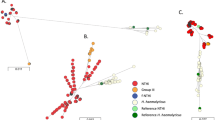Abstract
This study was undertaken to characterize serial Haemophilus parainfluenzae strains from epidemiologically unrelated chronic obstructive pulmonary disease (COPD) patients and from healthy carriers. A comprehensive approach was used including different phenotypical and molecular typing methods: biotyping, antibiotyping, conventional ribotyping, pulsed field gel electrophoresis (PFGE) assay, and PCR-ribotyping. Conventional ribotyping and PFGE analysis were confirmed as excellent procedures to differentiate isolates of the same species and biotype. Conversely, in our study, PCR-ribotyping proved to be suitable for taxonomic purposes, unambiguously identifying H. parainfluenzae from H. influenzae but not discriminating strains at the intraspecific level for epidemiological typing. Phylogenetic analysis of restriction fragment length polymorphism (RFLP) data of sequences related to the rrn operon demonstrated that H. parainfluenzae strains associated to COPD are spread among many diverging lineages.
Similar content being viewed by others
References
Kilian M. Haemophilus. In: Lennette EH, Balows A, Hausler WJ Jr, Shadomy HJ (eds), Manual of Clinical Microbiology. 4th ed. Washington, D. C.: American Society for Microbiology, 1985: 387–393.
Rhind GB, Gould GA, Ahmad F, Croughan MJ, Calder MA. Haemophilus parainfluenzae and H. influenzae reapiratory infections: Comparison of clinical features. Br Med J 1985; 291: 707–708.
Cole PJ. Host-microbe relationship in chronic respiratory infection. Respiration 1989; 55(suppl 1): 5–8.
Smith CB, Golden CA, Kanner RE, Renzetti AD. Haemophilus influenzae and Haemophilus parainfluenzae in chronic obstructive pulmonary disease. Lancet, June 12, 1976; 7972: 1253–1255.
Devalia JL, Harmanyeri Y, Cundell DR, Davies RJ, Grady D, Tabaqchali S. Variation in Histamine synthesis by Gram-negative and Gram-positive respiratory tract bacteria and the effect of cefaclor. In: Update on Haemophilus influenzae: how virulence, incidence and resistance affect treatment. Edited by R. Ringelmann. 1988; Series No 128: 49–55.
Grimont F, Grimont PAD. Ribosomal ribonucleic acid gene restriction patterns as potential taxonomic tools. Ann. Inst. Pasteur Microbiol 1986; 137b: 165–175.
Dasen SE, Li Puma JJ, Kostman JR, Stull TL. Characterization of PCR-Ribotyping for Burkholderia (Pseudomonas) cepacia. J Clin Microbiol 1994; 32: 2422–2424.
American Thoracic Society. Definitions and classification of chronic bronchitis, asthma, and pulmonary emphysema: A statement by the Commitee on Diagnostic Standards for Nontubercolosis Respiratory Disease. Am Rev Respir Dis 1962; 85: 762–768.
Kilian M. A rapid method for the differentiation of Haemophilus strains: The porphyrin test. Acta Pathol Microbiol Scand 1974; 82: 835–842.
Jorgensen JH, Redding JS, Maher LA, Howell AW. Improved medium for antimicrobial susceptibility testing of Haemophilus influenzae. J Clin Microbiol 1987; 25: 2105–2113.
Kilian M. A taxonomy study of the genus Haemophilus, with the proposal of a new species. J Gen Microbiol 1976; 93: 9–62.
Doern GV, Chapin KC. Determination of biotypes of Haemophilus influenzae and Haemophilus parainfluenzae. A comparison of methods and description of a new biotype (VIII) of H. parainfluenzae. Diagn Microb Infect Dis 1987; 7: 269–272.
National Commitee for Clinical Laboratory Standards (1990 a) Performance standards for Antimicrobial Disk Susceptibility Tests — Fourth Edition: Approved Standard M 2-A 4. NCCLS, Villanova, PA.
Pitcher DG, Saunders NA, Owen RJ. Rapid extraction of bacterial genomic DNA with guanidium thiocyanate. Lett Appl Microbiol 1989; 8: 151–156.
Sambrook J, Fritsch EF, Maniatis T. Molecular cloning: A laboratory manual, 2nd ed. New York: Cold Spring Harbor Laboratory, 1989: 383–386.
Curran R, Hardie HR, Towner KJ. Analysis by pulsedfield gel electrophoresis of insertion mutations in the transferrin-binding system of Haemophilus influenzae type b. J Med Microbiol 1994; 41: 120–126.
Bergey's manual of systematic bacteriology. Baltimore/London: Williams and Wilkins, 1984. Vol 1: 563, 566.
Sequences supplement. Nucl Ac Res 1990; 18.
Rossau R, Duhamel M, Jannes G, Decourt JL, Van Heuverswyn H. The development of specific rRNA-derived oligonucleotide probes for Haemophilus ducreyi, the causative agent of chancroid. J Gen Microbiol 1991; 137: 277–285.
Nei M, Li WH. Mathematical model for studying genetic variation in terms of restriction endonucleases. Proc Nat Ac Sc 1979; 76: 5269–5273.
Sneath PHA, Sokal RR. Numerical Taxonomy. San Francisco: WH Freeman & Co., 1973.
Arbeit RD, Arthur M, Dunn R, Kim C, Selander RK, Goldstein RK. Resolution of recent evolutionary divergence among Escherichia coli from related lineages: The application of Pulsed Field Electrophorcsis to molecular epiderniology. J Infect Dis 1990; 161: 230–235.
Selander RK, Caugant DA, Whittam TS. Genetic structure and variation in natural populations of Escherichia coli. In: Neidhart FC, Ingraham KI, Magasanik B, Low KB, Schaechter M Umbarger HE (eds), Escherichia coli and Salmonella typhimurium. Cellular and molecular biology Washington, DC: American Society for Microbiology, 1987: 1625–1848.
Caugant DA, Levin BR, Lidin-Janson G, Whittam TS, Svamborg Eden C, Selander RK. Genetic diversity and relationships among strams of Escherichia coli in the intestine and those causing urinary tract infections. Prog Allergy 1983; 33: 203–227.
Whittam TS, Waschsmuth IK, Wilson RA. Genetic evidence of clonal descent of Escherichia coli 0157: H7 associated with hemorragic colitis and hemolytic uremic syndrome. J Infect Dis 1988; 157: 1124–1133.
Hacker J, Blum-Oehler G, Muhldorfer I, Tschape H. Pathogenicity islands of virulent bacteria: Structure, function, and impact on microbial evolution. Molec Micr 1997; 23: 1089–1097.
Author information
Authors and Affiliations
Rights and permissions
About this article
Cite this article
Privitera, A., Licciardello, L., Gianninò, V. et al. Molecular epidemiology and phylogenetic analysis of Haemophilus parainfluenzae from chronic obstructive pulmonary disease exacerbations. Eur J Epidemiol 14, 405–412 (1998). https://doi.org/10.1023/A:1007405406617
Issue Date:
DOI: https://doi.org/10.1023/A:1007405406617




